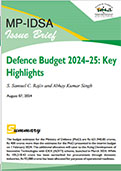Summary
The budget estimates for the Ministry of Defence (MoD) are Rs 621,940.85 crores, Rs 400 crores more than the estimates for the MoD presented in the interim budget on 1 February 2024. The additional allocation will cater to the Acing Development of Innovative Technologies with iDEX (ADITI) scheme, launched in March 2024. While Rs 105,518.43 crore has been earmarked for procurement through domestic industries, Rs 92,088 crores has been allocated for purposes of operational readiness.
Finance Minister Nirmala Sitharaman presented the regular Union Budget on 23 July 2024. The budget estimates for the Ministry of Defence (MoD) are Rs 621,940.85 crores, Rs 400 crores more than the estimates for the MoD presented in the interim budget on 1 February 2024.1 The MoD notes that the additional allocation of Rs 400 crores is for the Acing Development of Innovative Technologies with iDEX (ADITI) scheme.2 Table 1 shows the key estimates for the Ministry of Defence.
|
2023–24 (BE) |
2024–25 (BE) |
Percentage Increase |
|
|
Total Defence Budget |
593,537.64 |
621,940.85 |
4.78 |
|
MoD (Civil) |
22,612.5 |
25,963.18 |
14.81 |
|
Defence Services Revenue |
270,120.14 |
282,772.67 |
4.68 |
|
Capital Outlay on Defence Services |
162,600 |
172,000 |
5.78 |
|
Defence Pensions |
138,205 |
141,205 |
2.17 |
|
Pay and Allowances (Uniformed Personnel) |
140,988.31 |
146,083.6 |
3.61 |
|
DRDO |
23,263.89 |
23,855.61 |
2.54 |
|
Border Roads Development Board |
5,000 |
6,500 |
30 |
|
Coast Guard |
7,197.47 |
7,651.8 |
6.31 |
|
ECHS |
5,431.56 |
6,968 |
28.28 |
|
Agnipath |
4,266.14 |
5,979.28 |
40.15 |
Source: Union Budget, Ministry of Finance, Government of India.
ADITI is a sub-scheme of Innovation for Defence Excellence (iDEX) under the Department of Defence Production (DDP), MoD with a budget of Rs750 crores till 2026. The iDEX initiative itself was launched in April 2018, to provide financial support to start-ups, Medium, Small and Micro Enterprises (MSMEs) as well as individual innovators under the Defence Innovation Organisation (DIO) framework. The MoD signed the 350th contract with a defence start-up in June 2024. Since inception in 2018, the iDEX 11 editions of the Defence India Start-up Challenge (DISC) have been conducted and the MoD is in the process of procuring equipment selected through these challenges to the tune of Rs 2,000 crores.3
A significant new initiative that was announced by Finance Minister Sitharaman in the interim budget presented on 1 February 2024 related to the decision to launch a new scheme to provide long-term financing to the private sector for research and innovation in sunrise sectors with a corpus of Rs 100,000 crore. She had also announced that another scheme will be launched for strengthening ‘deep-tech’ technologies for defence purposes. The ADITI scheme was subsequently launched on 4 March 2024 to encourage innovations in ‘critical and strategic defence technologies’.4 These technologies were flagged as those related to satellite communication applications, advanced cyber technology, autonomous weapons, Artificial Intelligence (AI), Quantum Technologies (QT), among others.5
The long-term corpus of Rs 100,000 crore is reflective of the recognition that defence innovation will play a big role in optimally fulfilling the modernisation requirements of the armed forces. Current schemes like the Technology Development Fund (TDF) and iDEX which involve start-ups, academia and MSMEs have, therefore, become important enablers for tackling niche technological requirements of the armed forces.
Even as the private sector’s role in defence research and development (R&D) is poised for a big leap, the Defence Research and Development Organisation (DRDO) will continue to play a leading role in so far as defence R&D is concerned. The DRDO’s budget estimates for 2024–25 in the regular budget stand at Rs 23,855 crores, which is less than 4 per cent of the total defence budget. The government had recently constituted a High-Powered Committee to look into the functioning of the DRDO. The Committee has submitted its recommendations with reports in January 2024 noting that it has suggested further streamlining the work and structure of the premier R&D organisation in the service of the nation.
Adequate and optimum financial resources coupled with advances made as a result of defence R&D and innovation are expected to aid the defence indigenisation efforts of the MoD. This aspect is a critical component of the MoD’s efforts towards Atmanirbharta or self-reliance, given the fact that India cannot be self-reliant while continuing to depend on imports for addressing the weapons and equipment needs of the armed forces.
The armed forces are increasingly procuring equipment from the domestic defence industry. In 2020–21, the government specifically bifurcated the capital procurement budget for the armed forces between foreign and domestic procurement, allocating 40 per cent of the budget for domestic procurement. In 2023–24, this rose to 75 per cent of the capital procurement budget. It is significant to note that the Army, Navy and the Air Force spent more on domestic procurement during 2020–22 than what was budgeted for. During these years, the capital outlay for domestic procurement was Rs 130,000 crores while the three services procured more than Rs 150,000 crores from the domestic defence industry.6 The MoD notes that in the regular BE for 2024–25, Rs 105,518.43 crore or ‘75 per cent of the modernisation budget’ has been earmarked for procurement through domestic industries.7
The government has also allocated Rs 92,088 crores for purposes of operational readiness, 48 per cent higher than the actual allocations in 2022–23. The MoD notes that this is to ensure that the Indian Armed forces are ‘battle ready at all times’. The MoD further notes that these funds are to:
provide best maintenance facilities and support system to all platforms including aircraft and ships. It will facilitate procurement of ammunition; mobility of resources & personnel as demanded by the security situation, and strengthen the deployment in forward areas for any unforeseen situation.8
India’s defence budget for 2024–25 at Rs 621,940.85 crores is an increase of 4.78 per cent over the budget estimates (BE) for 2023–24. In the 2023–24 budget estimates, the defence budget was Rs 593,537 crores, which was less than 2 per cent of the GDP. The parliamentary Standing Committee on Defence (SCOD) has suggested in the recent past that the country’s defence budget should be at least 3 per cent of the gross domestic product (GDP) to ensure effective modernisation of the armed forces. While the MoD has maintained that funds allocated to the Ministry are commensurate with the requirements of the armed forces, the financial resources required for the modernisation of the armed forces requirements are indeed huge.
The SCOD in 2018 had, for instance, suggested that the Army equipment profile should ideally be 30 per cent of new equipment, 40 per cent current equipment and 30 per cent older generation equipment. The Army informed the SCOD in March 2023, five years later, that only 15 per cent of the Army’s equipment can be categorised as new equipment, while nearly 45 per cent continued to be older equipment. The Army representative informed the parliamentary committee that ‘there is some time to go before we reach the ideal state of 30:40:30’.9
The Army’s modernisation budget though has seen an average annual increase of 13.6 per cent during 2013–23, while the Navy and Air Force saw an increase of 11 per cent and 4 per cent respectively. No doubt, the Air Force accounted for the bulk of the modernisation budget allocations during this time period, at more than Rs 385,220 crores, as against Rs 273,460 crores for the Navy and Rs 201,716 crores for the Army.10
The modernisation budget is part of the Capital Outlay on Defence Services. The capital outlay budget for the armed forces has seen a cumulative annual growth rate (CAGR) of 9.8 per cent since 2014–15, while the Defence Services Estimate (DSE) (Revenue) budget has seen a CAGR of 7.9 per cent. The capital outlay expenditure, therefore, has seen a greater growth than revenue expenditure during this time period.
The larger chunk of the defence budget, however, goes towards meeting the revenue expenditure of the Ministry of Defence. In 2024–25 budget estimates, for instance, over 45 per cent of the total MoD budget is for DSE Revenue while about 28 per cent are the allocations for the Capital Outlay. Around 23 per cent goes towards Defence pensions, while the remaining allocations are for Demand No. 19, MoD (Civil) which encompasses revenue and capital establishment expenditure of the MoD (see Table 1).
The capital outlay on defence services in BE 2024–25 stands at Rs 172,000 crores. As in the February 2024 Interim Budget, consolidated capital demands of the three services are provided rather than being delineated for each Service. The MoD in February 2024 had noted that this was a ‘conscious call to foster jointness among the services by consolidating the demand of the three services’. It further noted that it will bring
flexibility in financial management by enabling the MoD to re-appropriate the fund among the three services keeping in view the inter services priority. This mechanism will also expedite decision making and ensure better utilisation of the capital budget.11
The consolidation of the capital outlay budget heads is, therefore, part of the broader defence reforms to make the budget process better tuned to meet the long-term planning and futuristic requirements of the armed forces as a whole. Such an integrated approach to budget planning could lead to better optimisation of financial resources. It needs to be pointed out though that lack of segregated data in the public domain on capital allocations to the three services will constrain independent analysis of the modernisation trajectory of India’s armed forces due to non-disclosure of granular details of capital expenditure in the defence budget.
Border road infrastructure development and adequately equipping the Coast Guard meanwhile continue to be key focus areas of the government. In the regular budget for 2024–25, Rs 6,500 crores has been allocated to the Border Roads Development Board, which is 30 per cent higher than BE 2023–24. The Coast Guard’s budget has seen a CAGR of nearly 10 per cent since 2015. BE 2024–25 allocations to the Coast Guard stand at Rs 7,651.8 crores.

As regard the budget estimates for the Agnipath scheme, in 2024–25, Rs 5,979 crores have been allocated, with the Army accounting for 87 per cent of the allocations. Graph 1 shows the Agnipath allocations as a percentage of Pay and Allowances of the three Services since 2022–23.
Conclusion
India’s defence modernisation challenges are huge. Adequate financial resources, defence indigenisation and defence innovation hold the key to build modern and agile fighting forces at the forefront of defending the country’s territorial integrity and sovereignty. Going forward, as the Indian domestic defence industry masters the defence R&D and innovation challenge, as Indian armed forces continue to procure more from the domestic industry, and optimum financial resources continue to be allocated to the armed forces, the armed forces capability gaps will no doubt be bridged faster with less dependence on foreign sources.
Views expressed are of the author and do not necessarily reflect the views of the Manohar Parrikar IDSA or of the Government of India.
- 1. For a Brief on the interim defence budget, see “Defence Budget 2024-25: Trend Analysis”, Issue Brief, Manohar Parrikar Institute for Defence Studies and Analyses (MP-IDSA), 16 February 2024.
- 2. “Rs 6.22 lakh crore Allocated to MoD, Highest Among Ministries, in Regular Union Budget 2024-25; 4.79% Higher than FY 2023-24”, Press Information Bureau, Ministry of Defence, Government of India, 23 July 2024.
- 3. “Landmark 350th iDEX Contract Inked; MoD to Collaborate with SpacePixxel Technologies Pvt Ltd for Design & Development of Miniaturised Satellite Capable of Carrying Multiple Payloads up to 150 kgs for Indian Air Force”, Press Information Bureau, Ministry of Defence, Government of India, 25 June 2024.
- 4. “DefConnect 2024: Raksha Mantri Launches ADITI Scheme to Promote Innovations in Critical & Strategic Defence Technologies”, Press Information Bureau, Ministry of Defence, Government of India, 4 March 2024.
- 5. Shayesta Nishat Ahmed, “Empowering Indigenous Defence Innovation: The ADITI Scheme and DefConnect 2024”, Comment, MP-IDSA, 3 April 2024.
- 6. See Standing Committee on Defence, Seventeenth Lok Sabha, Ministry of Defence, “Demands for Grants (2023-24), Army, Navy, Joint Staff, Ex-Servicemen Contributory Health Scheme, and Sainik Schools, Demand Nos 20 and 21, Thirty Sixth Report”, Lok Sabha Secretariat, March 2023, pp. 16, 23, 35; “Defence Budget 2024-25: Trend Analysis”, no.1, pp. 6–7.
- 7. “Rs 6.22 lakh crore Allocated to MoD, Highest Among Ministries, in Regular Union Budget 2024-25; 4.79% Higher than FY 2023-24”, no. 2.
- 8. Ibid.
- 9. “Demands for Grants (2023-24), Army, Navy, Joint Staff, Ex-Servicemen Contributory Health Scheme, and Sainik Schools, Demand Nos 20 and 21, Thirty Sixth Report”, no. 6, p. 18.
- 10. This includes allocations for Aircraft and Aero Engines, Heavy and Medium Vehicles, Other Equipment, Joint Staff, Procurement of Rolling Stock, Rashtriya Rifles, Naval Fleet, Naval Dockyard/Projects and Special Projects.
- 11. “Record Over Rs 6.21 lakh crore Allocation to Ministry of Defence in Interim Union Budget 2024-25; 4.72% More Than FY 2023-24”, Press Information Bureau, Ministry of Defence, Government of India, 1 February 2024.






